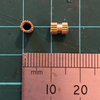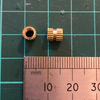spodokomodo
New Member
With the 50th anniversary of the Apollo 11 moon landing coming up later this year, I have decided to make a replica of the Display Keyboard (DSKY) from the Apollo Guidance Computer (AGC). I was inspired by Curious Marc on his youtube channel. He is working part of a team that are trying to get an original Apollo era AGC (missing the DSKY) up and running again.
A quick search brought up the "open DSKY project". I was almost ready to purchase one of their kits, but after doing some more research I concluded that it wasn't accurate enough for me - it is more of a function replica than a true replica - plus, I realised that researching, designing, problem solving and building my own was much going to be much more interesting - The fun is in building the replica DSKY, not owning it.
So where am I at? First, I have transcribed the drawings I could find into Fusion 360 I have made a few modifications (thickening parts) to make sure that the model can be 3D printed. I have now printed all the parts and worked my way through most of the problems so I have a rough fit model put together.
I've included some photographs, but I only have a phone camera (and poor lighting) so I will supplement this with screen shots of the CAD model (I havent got the patience for proper renderings)
The next step is to take this apart for sanding, painting, finishing etc. While I have the DSKY in parts I intend to document each sub-assembly in an individual post.
Ultimately I intend release the 3D files and BOM to the community, but won't do this until I have a completely assembled unit incase I need to make any changes.
I will try to include all of the references I use as it may help if someone wants to make a their own more accurate version.
--
There are plenty of photographs of the DSKY internet, but you need to be carefull as many of these are of other replicas - I found some of the best photo resources are auction companies who were selling non-flown DSKYs (I won't link to the photos here in case of copyright problems, but they are easy to find).
A good overall resource is the Virtual AGC project, which has extensive documentation on the various versions of the DSKY/AGC with links to an incomplete set of original NASA/MIT/Raytheon drawings. These are a mixture of the block 1 and block 2 DKSY drawings and cover various versions and modifications made to the DSKY over the length of the Apollo program.
Fran Blanche, on her youtube channel, has a long term project to remake the display part of the DSKY using the original manufacturing processes. There is a video (Apollo AGC DSKY Display Project, Pt.1) where she has the opportunity to partially disassemble a non-flown DSKY. This was really useful, being able to see the internal components as physical objects rather than just the scanned engineering drawings.
Reference:
Open DSKY project - https://opendsky.com
Virtual AGC project - Virtual AGC Home Page
Virtual ACG project documentation - Virtual AGC Project : Free Texts : Free Download, Borrow and Streaming : Internet Archive
Curious Marc - CuriousMarc
Fran Blanche - Fran Blanche
Paper model - DSKY (DISPLAY KEYBOARD APOLLO GUIDANCE COMPUTER (AGC) FROM LM-5 - MODEL ART CRAFT KIT 1:1
Carl Claunch - Rescue 1130: 2014 Pickup of an IBM 1130 System and More
RPF threads:
Apollo LEM-5 DSKY/AGC
Has anyone built a replica DSKY from the Apollo Guidance Computer? >>







A quick search brought up the "open DSKY project". I was almost ready to purchase one of their kits, but after doing some more research I concluded that it wasn't accurate enough for me - it is more of a function replica than a true replica - plus, I realised that researching, designing, problem solving and building my own was much going to be much more interesting - The fun is in building the replica DSKY, not owning it.
So where am I at? First, I have transcribed the drawings I could find into Fusion 360 I have made a few modifications (thickening parts) to make sure that the model can be 3D printed. I have now printed all the parts and worked my way through most of the problems so I have a rough fit model put together.
I've included some photographs, but I only have a phone camera (and poor lighting) so I will supplement this with screen shots of the CAD model (I havent got the patience for proper renderings)
The next step is to take this apart for sanding, painting, finishing etc. While I have the DSKY in parts I intend to document each sub-assembly in an individual post.
Ultimately I intend release the 3D files and BOM to the community, but won't do this until I have a completely assembled unit incase I need to make any changes.
I will try to include all of the references I use as it may help if someone wants to make a their own more accurate version.
--
There are plenty of photographs of the DSKY internet, but you need to be carefull as many of these are of other replicas - I found some of the best photo resources are auction companies who were selling non-flown DSKYs (I won't link to the photos here in case of copyright problems, but they are easy to find).
A good overall resource is the Virtual AGC project, which has extensive documentation on the various versions of the DSKY/AGC with links to an incomplete set of original NASA/MIT/Raytheon drawings. These are a mixture of the block 1 and block 2 DKSY drawings and cover various versions and modifications made to the DSKY over the length of the Apollo program.
Fran Blanche, on her youtube channel, has a long term project to remake the display part of the DSKY using the original manufacturing processes. There is a video (Apollo AGC DSKY Display Project, Pt.1) where she has the opportunity to partially disassemble a non-flown DSKY. This was really useful, being able to see the internal components as physical objects rather than just the scanned engineering drawings.
Reference:
Open DSKY project - https://opendsky.com
Virtual AGC project - Virtual AGC Home Page
Virtual ACG project documentation - Virtual AGC Project : Free Texts : Free Download, Borrow and Streaming : Internet Archive
Curious Marc - CuriousMarc
Fran Blanche - Fran Blanche
Paper model - DSKY (DISPLAY KEYBOARD APOLLO GUIDANCE COMPUTER (AGC) FROM LM-5 - MODEL ART CRAFT KIT 1:1
Carl Claunch - Rescue 1130: 2014 Pickup of an IBM 1130 System and More
RPF threads:
Apollo LEM-5 DSKY/AGC
Has anyone built a replica DSKY from the Apollo Guidance Computer? >>












































